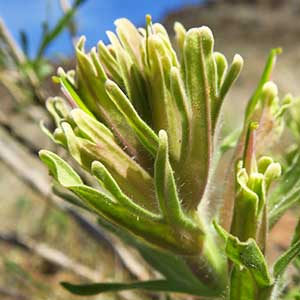Castilleja xanthotricha
Castilleja uliginosa
John Day or yellow-hairy paintbrush, John Day paintbrush, yellow hair paintbrush, yellow-hair Indian paintbrush
Pitkin Marsh Indian paintbrush, Pitkin Marsh paintbrush
few to several, ± decumbent to erect or ascending, unbranched, sometimes with short, leafy axillary shoots, hairs erect to spreading, long, soft, eglandular, mixed with short stipitate-glandular ones.
several, decumbent proximally and sometimes becoming weakly rhizomatous, becoming ascending to erect, unbranched or often branched proximally, hairs spreading, short and long, soft, mixed eglandular and stipitate-glandular.
green, linear, lanceolate to broadly lanceolate, oblong, or cuneate, 0.8–5 cm, not fleshy, margins plane to wavy, involute, 0–5-lobed, apex acute, sometimes rounded;
lobes spreading, linear, arising below mid length, nearly as broad as center lobe, apex acute.
green, lanceolate or broadly lanceolate, 3–5 cm, much reduced distally, not fleshy, margins plane, sometimes ± wavy, flat, 0-lobed, apex acute to rounded.
3–14 × 1.5–4.5 cm;
bracts proximally greenish, rarely dull reddish purple, distally white to cream, rarely pale yellow or dull, pale pink (sharply differentiated from proximal coloration), lanceolate or oblong to narrowly ovate, (3–)5–7-lobed;
lobes ascending, linear to obovate, ± broadened distally, medium, long, proximal lobes arising below mid length, central lobe apex broadly rounded to truncate, others acute to rounded.
10–30 × 3–4 cm;
bracts pale yellow to cream throughout, or proximally pale greenish near base, distally pale yellow to cream, broadly lanceolate, 3-lobed;
lobes ascending, narrowly lanceolate, long, arising near mid length, apex narrowly acute or acuminate.
curved, 17–23 mm;
tube 15–19 mm;
beak exserted, adaxially green, 5–8(–9) mm, puberulent, stipitate-glandular;
abaxial lip deep purple (color sometimes visible through calyx), green, pinkish, or pale yellow, ± prominent, slightly inflated, usually hidden in calyx, sometimes right at top of calyx, 2 mm, ca. 50% as long as beak;
teeth ascending, whitish, yellowish, pink, or green, 1–1.5 mm.
slightly curved, 22–30 mm;
tube 11–15 mm;
beak partly exserted, adaxially whitish, yellowish, or greenish, 10–15 mm;
abaxial lip green, small, protuberant, 3 mm, ca. 20% as long as beak;
teeth erect to incurved, green, to 1 mm.
colored as bracts, 15–26 mm;
abaxial and adaxial clefts 3.5–7 mm, 25–50% of calyx length, deeper than laterals, lateral 2–5 mm, 12–25% of calyx length;
lobes linear, oblong, or narrowly triangular, center lobe apex usually rounded, lobes acute to rounded.
colored as bracts, 20–25 mm;
abaxial and adaxial clefts 7–14 mm, ca. 50% of calyx length, deeper than laterals, lateral 5–6 mm, ca. 33% of calyx length;
lobes linear, apex acute, ciliate.
= 48.
Castilleja xanthotricha
Castilleja uliginosa
Castilleja xanthotricha is endemic to moderate elevations in the sagebrush hills of the John Day River drainage in north-central Oregon. N. H. Holmgren (1971) hypothesized that this tetraploid species is of allopolyploid hybrid origin between C. glandulifera and C. oresbia.
(Discussion copyrighted by Flora of North America; reprinted with permission.)
Castilleja uliginosa is endemic to Pitkin Marsh in Sonoma County. It differs from C. miniata by its uniformly pale yellow inflorescences and pubescent stems, as well as by its disjunct, low-elevation habitat. Much of its available habitat was destroyed by development, and it is apparently now extirpated from the wild. It survives in the form of tissue clones from the last wild plant, backcrossed with C. miniata by L. R. Heckard in the 1980s and maintained since then in the greenhouses at the University of California at Berkeley.
(Discussion copyrighted by Flora of North America; reprinted with permission.)
